Discover the Enigmatic Ruins of Guge Kingdom: A Journey Through Tibet’s Ancient Civilization
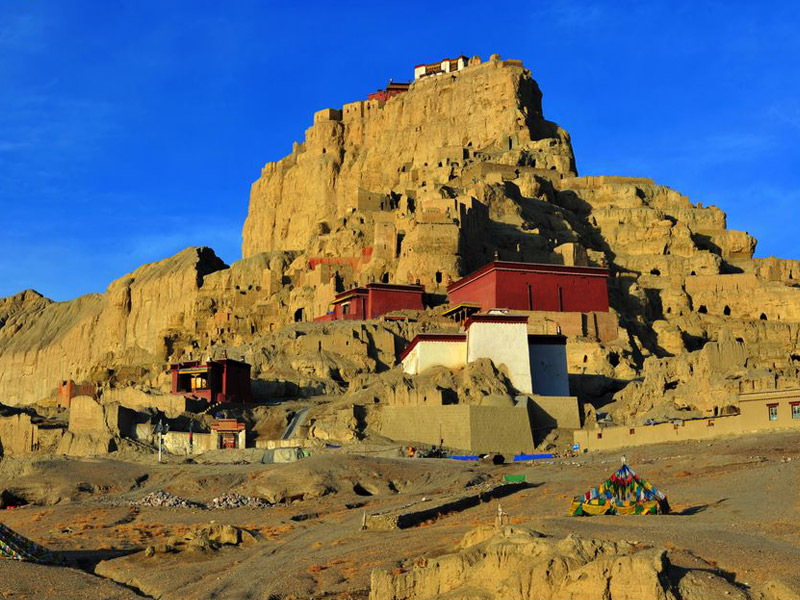
An Essential Guide to Visiting Ruins Of Guge Kingdom
Nestled in the remote reaches of western Tibet, the Ruins of Guge Kingdom beckon adventurous travelers with their enigmatic allure and breathtaking landscapes. Once a flourishing center of Buddhist culture and cross-cultural exchange, this ancient kingdom thrived for nearly seven centuries before mysteriously vanishing into the annals of history. The remnants of its grandeur, perched dramatically above the Sutlej River, offer a glimpse into a bygone era filled with vibrant murals, intricate architecture, and tales of spiritual enlightenment.
Visiting Guge is akin to stepping into a time capsule where the echoes of centuries resonate amidst the stark beauty of the Himalayan plateau. Here, crumbling palaces and hidden tunnels tell stories of a rich heritage, while the colorful frescoes that adorn its walls invite contemplation and wonder. As you explore the labyrinthine ruins, you’ll find yourself captivated by the profound silence and the haunting beauty of the arid landscape that surrounds you.
This guide is your gateway to discovering the treasures of Guge Kingdom, from practical travel tips to must-see highlights that will enrich your journey. Whether you’re a history enthusiast, a photography lover, or simply in search of spiritual serenity, the ruins promise an unforgettable experience that lingers in the heart long after your visit. Prepare to embark on an adventure that transcends time, and immerse yourself in the mystique of this ancient Tibetan kingdom.
In This Guide
- An Essential Guide to Visiting Ruins Of Guge Kingdom
- The Rich History and Legends of Ruins Of Guge Kingdom
- Main Highlights: What You Absolutely Can’t Miss
- Planning Your Visit: A Practical Guide
- Tickets: Prices, Booking, and Tips
- How to Get There: A Complete Transportation Guide
- Local Cuisine and Accommodation Nearby
- Frequently Asked Questions
- Final Thoughts on Your Trip
The Rich History and Legends of Ruins Of Guge Kingdom
Nestled high in the rugged landscapes of western Tibet, the Ruins of Guge Kingdom stand as a testament to a vibrant and mysterious past. Founded in the 10th century by the descendants of the Tibetan royal lineage, Guge blossomed into a cultural and religious hub that thrived for nearly 700 years. Its capital, Tholing, became a beacon of Buddhist revival, attracting scholars and artists from across the region. The legacy of Guge is intertwined with the spread of Buddhism in Tibet, notably through the efforts of the revered translator Rinchen Zangpo, who played a crucial role in the translation of Buddhist texts into Tibetan.
The kingdom’s development was marked by a unique blend of Tibetan, Indian, and Central Asian influences, manifested in its art, architecture, and spiritual practices. From the intricate frescoes adorning its temples to the grand structures of its palaces, the artistic heritage of Guge is rich and diverse. The kingdom reached its zenith during the 11th century, becoming a flourishing independent state characterized by its thriving trade routes and cultural exchanges.
However, the glory of Guge was not to last. In the mid-17th century, a fierce conflict erupted between Guge and the neighboring kingdom of Ladakh, leading to a catastrophic downfall. The ruins that remain today are a haunting reflection of this once-great civilization, which vanished almost overnight. The royal family disappeared without a trace, leaving behind a legacy steeped in legend and mystery. Some tales recount miraculous escapes and hidden treasures, while others speak of the last king’s desperate attempts to save his kingdom from destruction.
Exploring the ruins today feels like stepping into a time capsule, where the silence of centuries whispers tales of valor and despair. Visitors can wander through the remains of the royal palace complex, with its intricate network of over 400 rooms and 879 caves, each adorned with ancient murals depicting Buddhist teachings and local legends. The expansive site also features 28 pagodas and several hidden tunnels, which were once used for defense and escape.
The legends of Guge are not just relics of the past; they are stories that continue to captivate the imagination of travelers and historians alike. As you explore this mystical site, each mural and stupa tells a tale, bringing the ancient legends of Guge to life. Whether it’s the vibrant depictions of Buddhist saints or the faded inscriptions on weathered stone walls, the rich history of Guge Kingdom invites you to uncover the mysteries of a lost empire, making it an unforgettable destination for the adventurous traveler.
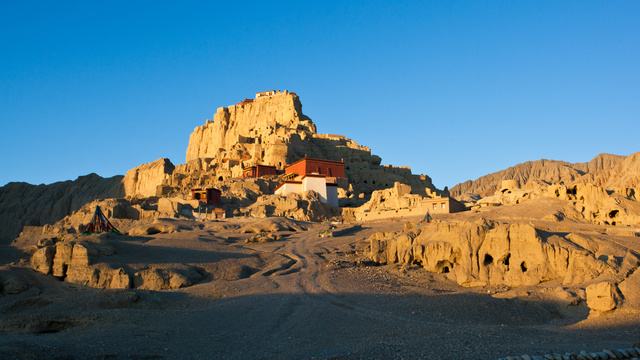
Ruins Of Guge Kingdom.
Main Highlights: What You Absolutely Can’t Miss
The Ruins of Guge Kingdom is a treasure trove of history and culture, enveloped in an air of mystery that beckons adventurous travelers. As you traverse this enchanting site, there are several key highlights that simply cannot be missed.
Royal Palace Complex
Begin your exploration at the Royal Palace Complex, the heart of the Guge Kingdom. Ascend the steep pathways to the summit, where you will be rewarded with breathtaking 360° views over the Sutlej River canyon and the expansive Ngari plateaus. The remnants of the palace itself evoke a sense of grandeur, allowing you to imagine the splendor that once defined this ancient kingdom.
White Temple (Lhakang Karpo)
Next, make your way to the White Temple, known as Lhakang Karpo. This remarkable structure houses exquisite frescoes and sculptures that showcase a blend of Buddhist, Kashmiri, and Himalayan influences. As you stand before these vibrant artworks, you’ll gain insight into the spiritual heritage that flourished during Guge’s golden age.
Red Temple (Lhakang Marpo)
Just a stone’s throw away is the Red Temple, or Lhakang Marpo. This temple is adorned with striking murals that narrate tales from Tibetan Buddhism. The vivid colors and intricate details of the paintings provide a fascinating glimpse into the religious and cultural narratives that shaped the kingdom.
Stupas and Pagodas
The site boasts 28 unique stupas and pagodas, each rich with symbolism tied to Tibetan cosmology. As you wander among these structures, take the time to appreciate their architectural beauty and the spiritual significance they hold within the Buddhist faith.
Secret Tunnels and Caves
One of the most intriguing aspects of the Ruins of Guge is its network of secret tunnels and caves. Historically used for meditation, escape, and defense, several of these tunnels are safe for exploration today. Delve into the shadows of these hidden passages to uncover the stories they hold, and enjoy the unique atmosphere that surrounds them.
Tholing Monastery
Don’t miss a visit to Tholing Monastery, once the intellectual and spiritual epicenter of the Guge Kingdom. This monastery still stands as a testament to the artistic prowess of its time, with stunning murals that have survived the ravages of time. Take a moment to sit in quiet reflection as you admire the artistry that graces the walls.
Sunrise and Sunset Views
For photography enthusiasts, the magical moments of sunrise and sunset at Guge Kingdom are not to be missed. The shifting light transforms the landscape into a canvas of colors, enhancing the mystical aura of this ancient site. Capture the beauty of the ruins bathed in golden light, and let the serenity of the surroundings seep into your soul.
Final Thoughts
Each corner of the Ruins of Guge Kingdom reveals a layer of history waiting to be discovered. As you explore this captivating site, allow yourself to be enveloped by the stories, artistry, and breathtaking views that define this lost kingdom. Prepare for an adventure that will linger in your memories long after you depart from this remarkable piece of Tibetan heritage.
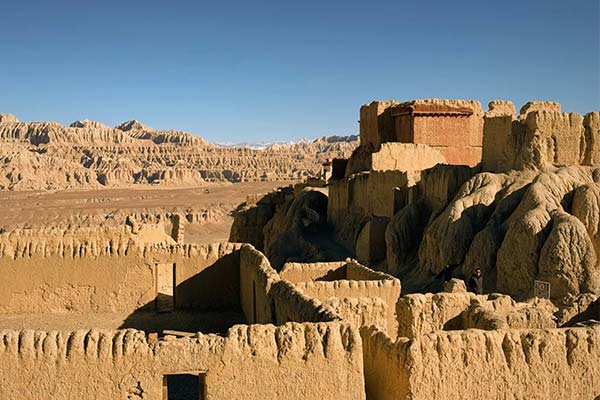
Ruins Of Guge Kingdom.
Planning Your Visit: A Practical Guide
Planning Your Visit: A Practical Guide to the Ruins of Guge Kingdom
Nestled in the remote landscapes of western Tibet, the Ruins of Guge Kingdom beckon adventurous travelers with their haunting beauty and rich history. As you prepare for this extraordinary journey, here’s everything you need to know for a seamless and enriching experience.
Getting There
Location:
The Guge Kingdom ruins are located near Tholing and Tsaparang, around 18 kilometers west of Zanda County in Ngari Prefecture, Tibet. This isolated site is approximately 1,450 kilometers from Lhasa and sits at an elevation of about 3,800 meters.
Travel Options:
1. By Air and Road:
– Fly from Lhasa to Ngari Gunsa Airport (Ali) – a flight lasting 2 to 2.5 hours.
– From the airport, take a scenic 6-7 hour drive (approximately 250 km) to Zanda, followed by a short drive to the ruins.
- Overland Adventure:
- Embark on an overland tour from Lhasa, traversing through Shigatse, Saga, Lake Manasarovar, and Mount Kailash. This route, known as the “Tibet Great West Road,” offers breathtaking scenery and opportunities for acclimatization before reaching Guge.
Permits:
Travelers must secure specific permits to visit Tibet, including:
– Tibet Travel Permit (TTP)
– Aliens’ Travel Permit (ATP) for Ngari
– Military Permit, if required
It’s essential to book your trip through a licensed agency that can assist with these permits, ensuring compliance with local regulations.
Best Times to Visit
Optimal Seasons:
– May to June & Mid-September to Early October: These months offer mild weather, clear skies, and accessible roads, making them the best times to explore Guge.
– April and October: Considered shoulder months, they provide a quieter experience with pleasant temperatures.
Avoid:
– Winter (November to March): Extremely cold temperatures can hinder access.
– July & August: While the scenery is lush, rain can lead to road delays.
What to See and Do
The ruins of Guge Kingdom are an archaeological wonder, replete with historical relics:
- Royal Palace Complex: Climb to the summit for breathtaking views of the Sutlej River canyon.
- White Temple (Lhakang Karpo): Marvel at the intricate frescoes and sculptures that showcase the artistic fusion of Tibetan, Indian, and Central Asian influences.
- Red Temple (Lhakang Marpo): Discover vibrant murals depicting the golden age of Tibetan Buddhism.
- Stupas and Pagodas: Explore 28 unique stupas, each rich in symbolism.
- Hidden Tunnels and Meditation Caves: Delve into ancient passageways used for escape and meditation.
- Tholing Monastery: Visit this former spiritual center known for its stunning murals.
Photography Tip: Both sunrise and sunset provide incredible light for capturing the dramatic landscapes, so plan your visits accordingly.
Practical Travel Tips
Health and Safety:
– Acclimatization is crucial due to the high altitude; spend a few days in Lhasa or Shigatse before heading to Guge.
– Stay hydrated and listen to your body to avoid altitude sickness.
Packing Essentials:
– Clothing: Layers are key; bring warm clothing even in summer, as temperatures can drop at night.
– Sun Protection: Due to the high elevation, sun exposure is intense; sunscreen and hats are advisable.
– Personal Items: Carry basic medicines, a refillable water bottle, and snacks for your journey.
Accommodation:
Expect rustic guesthouses in Zanda, as luxury options are limited. Embrace the simplicity and charm of local hospitality.
Language and Interaction:
While Tibetan and Mandarin are the primary languages, your guide will assist with communication. Always be respectful; ask before taking photos of people or entering sacred spaces.
Final Thoughts
Visiting the Ruins of Guge Kingdom is more than just a trip; it’s a journey into the heart of Tibet’s spiritual and historical tapestry. Prepare well, travel responsibly, and allow the whispers of this ancient kingdom to enchant you. Whether you’re an avid historian or a curious traveler, Guge promises an unforgettable adventure that connects you to the essence of Tibetan culture and history.
Embark on your journey with an open heart and mind, and let the magic of Guge unfold before you!
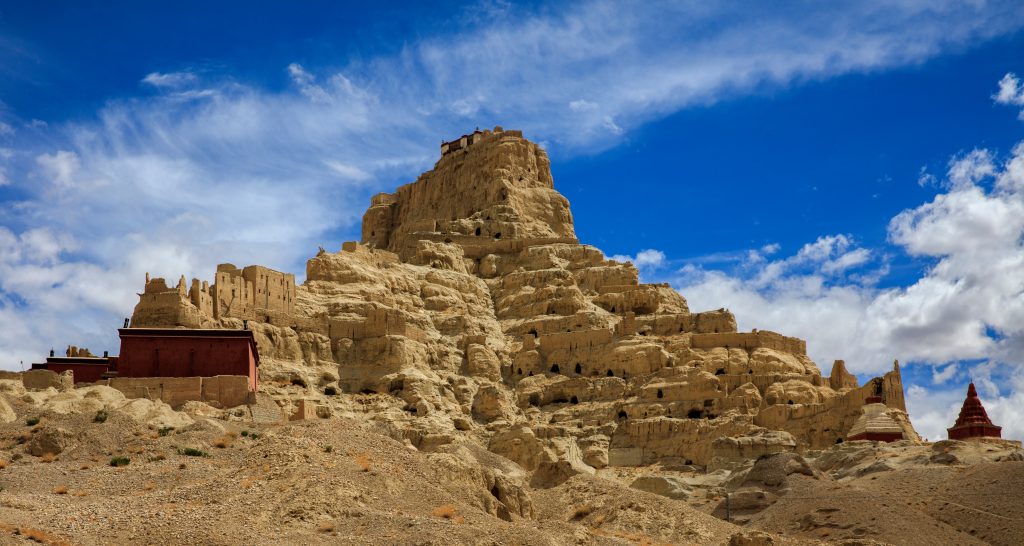
Ruins Of Guge Kingdom.
Tickets: Prices, Booking, and Tips
When planning your visit to the captivating Ruins of the Guge Kingdom, understanding the ticketing process is essential for a smooth and enjoyable experience. Here’s everything you need to know about prices, booking, and insider tips to enhance your journey into Tibet’s ancient past.
Ticket Prices
Visiting the ruins typically requires an entrance fee, which helps maintain the site and supports local conservation efforts. As of 2023, the ticket prices for the Guge Kingdom are approximately:
- Entrance Fee: ¥50 (around $8 USD) per person
- Guided Tours: If you prefer a more in-depth exploration, hiring a local guide can cost an additional ¥100-¥200 (around $15-$30 USD) depending on the length and detail of the tour.
Booking Your Tickets
While tickets can often be purchased on-site, it is advisable to arrange your visit through a licensed travel agency, especially for foreign travelers. Most tours include entry fees in their packages, simplifying the process and ensuring you have a knowledgeable guide to enhance your experience.
If you’re embarking on an overland tour from Lhasa, your agency will typically handle all necessary arrangements, including permits and tickets. This not only saves time but also provides peace of mind, allowing you to focus on the breathtaking landscapes and rich history.
Tips for a Seamless Visit
-
Arrive Early or Late: The Guge Kingdom is less crowded in the early morning or late afternoon, allowing for a more serene experience. Plus, the lighting during these times is perfect for photography—especially during sunrise and sunset when the ruins take on a magical glow.
-
Acclimatization: Given that the ruins sit at an elevation of around 3,800 meters (12,467 feet), it’s crucial to acclimatize properly. Spend a few days in Lhasa or nearby areas before your visit to avoid altitude sickness.
-
Cash is King: Ensure you have enough cash on hand, as many local services (including ticket sales at the site) may not accept credit cards.
-
Dress Appropriately: The weather can change rapidly in the Tibetan highlands. Wear layers and bring sun protection, as the UV rays can be intense at high altitudes.
-
Respect Local Customs: When visiting the site, remember to dress modestly and be respectful of the ruins and local culture. Always ask permission before taking photographs of people.
By planning ahead, booking through a reliable agency, and following these tips, your visit to the Ruins of Guge Kingdom will be an unforgettable adventure into the heart of Tibet’s rich history. Prepare to be mesmerized by the echoes of an ancient civilization amidst stunning landscapes.
How to Get There: A Complete Transportation Guide
Reaching the Ruins of the Guge Kingdom is an adventure in itself, promising a journey filled with stunning landscapes and a glimpse into Tibet’s rich history. Here’s your comprehensive guide to navigating the various transportation options available to get you to this mystical destination.
By Air
The most efficient way to begin your journey is by flying from Lhasa to Ali (Ngari Gunsa) Airport. This flight takes approximately 2 to 2.5 hours and is often celebrated for the breathtaking aerial views of the Tibetan Plateau. Once you arrive at Ali Airport, the next leg of your journey will be a scenic drive to Zanda County.
Road Transfer from Ali Airport
After landing at Ali Airport, you will need to arrange a road transfer to Zanda (Tsada), which is about 250 kilometers away. The drive typically takes between 6 to 7 hours. The route offers stunning vistas, including views of the Sutlej River and the surrounding arid landscapes, making it an unforgettable experience. It’s recommended to hire a local driver or join an organized tour for this segment to ensure safety and comfort.
Overland Adventure from Lhasa
For those seeking an adventurous route, consider embarking on an overland tour from Lhasa. This journey will take you through several captivating destinations, including Shigatse, Saga, Lake Manasarovar, and the sacred Mt. Kailash. This classic route, known as the “Tibet Great West Road,” not only allows for acclimatization but also immerses you in the dramatic beauty of western Tibet.
Suggested Overland Itinerary:
- Lhasa: Spend a few days acclimatizing and exploring the spiritual heart of Tibet.
- Shigatse: Visit Tashilhunpo Monastery, the seat of the Panchen Lama.
- Saga: A stopover where you can enjoy local culture.
- Lake Manasarovar and Mt. Kailash: Experience the breathtaking beauty and spiritual significance of these sacred sites.
- Zanda: Finally, arrive at Zanda, the gateway to the Guge Kingdom.
This overland journey is ideal for those who wish to take their time and soak in the majestic scenery and cultural richness along the way.
Travel Permits
It’s important to note that foreign travelers are required to obtain specific permits to visit Tibet, including the Tibet Travel Permit (TTP) and the Aliens’ Travel Permit (ATP) for the Ngari region. These must be arranged through a licensed travel agency, which will assist in the entire process, so ensure you make the necessary arrangements well in advance.
Best Time to Travel
When planning your trip, consider the best times to visit Guge Kingdom. The ideal seasons are from May to June and mid-September to early October, when the weather is mild, and the roads are accessible. While winter (November to March) is best avoided due to extreme cold and possible road closures, April and October can offer quieter experiences with cooler temperatures.
Final Thoughts
Traveling to the Ruins of Guge Kingdom is more than just a journey; it’s an expedition into the heart of Tibetan history and culture. Whether you choose to fly or take the scenic overland route, prepare for an adventure that will leave you with lasting memories and a deeper understanding of this enchanting region. Remember to pack essentials for high-altitude travel, and enjoy the spiritual and historical wonders that await you in this lost kingdom.
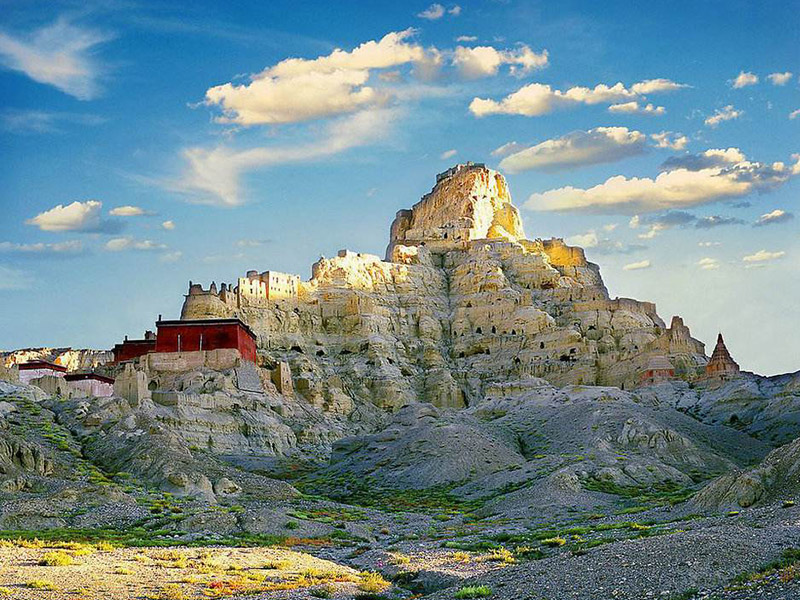
Ruins Of Guge Kingdom.
Local Cuisine and Accommodation Nearby
When visiting the mystical Ruins of Guge Kingdom, experiencing local cuisine and finding suitable accommodation can enhance your journey into this ancient realm. Nestled in the dramatic landscape of western Tibet, the area around Guge is rustic yet rich in local culture, offering travelers a taste of authentic Tibetan hospitality.
Dining Options Near Guge Kingdom
Local Tibetan Cuisine
While dining options are limited, the simple eateries in Zanda (Tsada) County serve traditional Tibetan dishes that reflect the region’s culinary heritage. Here are a few must-try dishes:
-
Momos: These steamed dumplings are a staple in Tibetan cuisine, often filled with meat or vegetables and served with a tangy dipping sauce. They make for a hearty snack after a day of exploring the ruins.
-
Thukpa: This comforting noodle soup is perfect for the high-altitude climate, typically made with meat, vegetables, and a fragrant broth. It’s a filling option that will keep you warm and energized.
-
Tsampa: A traditional Tibetan staple made from roasted barley flour, tsampa is often eaten with butter tea or formed into balls with water. It’s a simple yet nutritious option that provides a taste of local life.
-
Butter Tea (Po Cha): A unique beverage made from tea, yak butter, and salt, butter tea is a quintessential Tibetan drink. It’s creamy, savory, and provides a boost of energy, making it a great companion for your adventures.
Where to Eat:
Most of the dining options are found in local guesthouses or small family-run restaurants in Zanda. Be sure to ask your accommodation for recommendations on where to enjoy authentic Tibetan meals.
Accommodation Options Nearby
Guesthouses in Zanda
While luxury accommodations are scarce, Zanda offers several guesthouses that provide a comfortable base for your explorations. Here are a couple of notable options:
-
Zanda Hotel: A popular choice among travelers, this hotel offers basic yet clean rooms with stunning views of the surrounding landscape. The on-site restaurant serves a selection of Tibetan dishes, making it convenient for guests.
-
Local Guesthouses: There are various family-run guesthouses scattered throughout Zanda. These establishments often provide a cozy atmosphere and a chance to engage with local families. Staying in a guesthouse not only supports the local economy but also allows for a more immersive experience in Tibetan culture.
Tips for Accommodation:
– Book in Advance: Given the limited options and the increasing interest in the Guge Kingdom, it’s wise to reserve your accommodation ahead of time, especially during peak travel seasons from May to June and mid-September to early October.
- Expect Basic Amenities: While comfort may vary, most guesthouses provide essential amenities like hot water and basic bedding. Embrace the rustic charm of these lodgings as part of your adventure.
By sampling the local cuisine and staying in nearby accommodations, you’ll deepen your appreciation for the rich culture and history surrounding the Ruins of Guge Kingdom. Prepare for an unforgettable journey through one of Tibet’s most enchanting destinations!
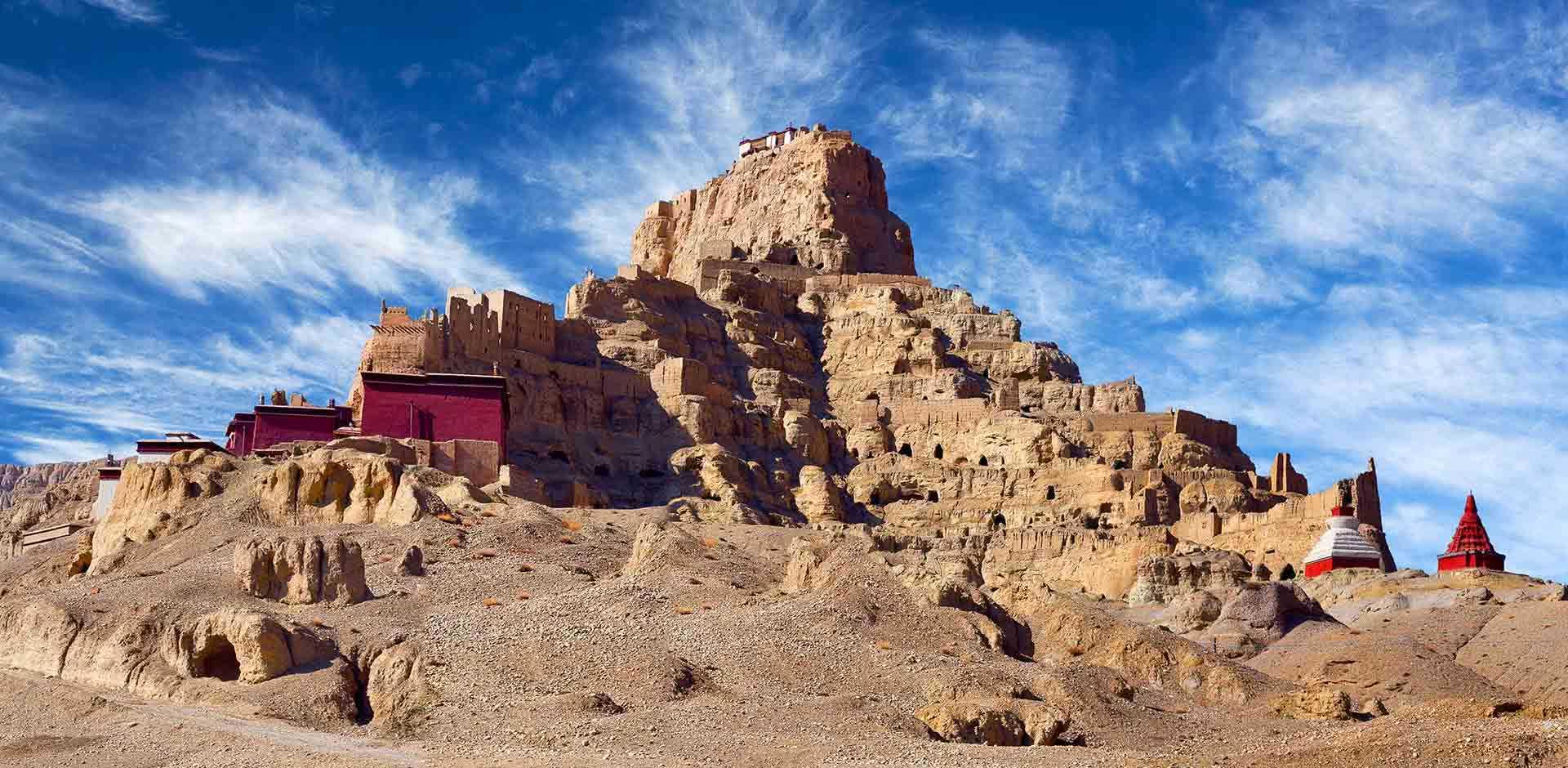
Ruins Of Guge Kingdom.
Frequently Asked Questions
-
Can I visit the Ruins of Guge Kingdom independently?
No, independent travel is not permitted for foreign passport holders. You must arrange your visit through a licensed local travel agency, which will handle the necessary permits and logistics. -
How many days should I plan for visiting Guge Kingdom?
It is recommended to spend at least two days in the Zanda/Guge area to fully explore the ruins and acclimatize to the altitude, in addition to the time needed for your journey to and from the site. -
What is the best time to visit the Guge Kingdom?
The ideal seasons to visit are from May to June and mid-September to early October, when the weather is mild, and the roads are accessible. April and October can also be pleasant for those seeking a quieter experience. -
What are the main highlights to see at Guge Kingdom?
Key attractions include the Royal Palace Complex, the White Temple (Lhakang Karpo), the Red Temple (Lhakang Marpo), numerous stupas and pagodas, and the fascinating secret tunnels and caves, along with Tholing Monastery. -
What should I pack for my trip to Guge Kingdom?
Essential items include warm clothing, sunscreen, a refillable water bottle, snacks, and any necessary medications. Comfortable walking shoes are a must for exploring the ruins. -
Are there accommodations near Guge Kingdom?
Accommodations in Zanda are generally simple guesthouses, as luxury options are limited. Be prepared for a rustic experience, as amenities may be basic. -
What health precautions should I take before visiting?
Acclimatization is crucial due to the high altitude of over 3,800 meters. Spend a few days in Lhasa or Shigatse before heading to Guge to help your body adjust. -
Can I take photographs at the Ruins of Guge Kingdom?
Yes, photography is allowed, but be mindful of local customs. Always check for any restrictions within temples and ask for permission before photographing locals or sacred sites.
Final Thoughts on Your Trip
As you prepare to conclude your journey to the captivating Ruins of Guge Kingdom, take a moment to reflect on the extraordinary tapestry of history that envelops you. This once-thriving kingdom, founded by descendants of the Tibetan royal lineage, whispers tales of ancient wisdom, cultural exchange, and spiritual fervor. Amidst the remnants of palaces, monasteries, and breathtaking murals, you’ve not merely witnessed a site of archaeological significance; you’ve stepped into a living narrative that resonates with the echoes of time.
The Arid beauty of the landscape, framed by the majestic Himalayas and the Sutlej River, offers an unparalleled backdrop for contemplation and adventure. Each stair you climbed, each secret tunnel you explored, has drawn you closer to the essence of a civilization that danced on the edge of history. The silence of Guge speaks volumes, inviting you to meditate on the serene spirituality that once thrived here, and perhaps even prompting you to ponder your own journey.
As you leave this mystical land, carry with you the spirit of discovery and the stories of the past, allowing them to inspire future adventures. The Ruins of Guge Kingdom are not just remnants of what once was; they are a testament to the resilience of culture and the enduring allure of exploration. Embrace the memories you’ve forged and let them illuminate your path ahead—wherever your travels may lead next.